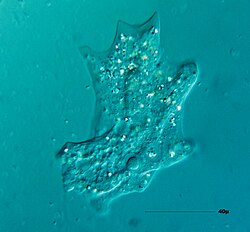Organismo

Sabiyolohiya,anorganismo(Ingles:organism;gikan sa Griyego: ὀργανισμός,organismos) iyo an maski anong organiko, nabubuhay na sistema na minagana bilang sarong indibidwal na entidad.[1]An gabos na organismo iyo pigbibilog ninselula(teorya nin selula).[1]An mga organismo iyo pigkaklasipika nintaksonomiyasa mga grupo arug kan mga multiselular nahayop,tinanom,asinfungi;o uniselular namikroorganismoarug kan mgaprotista,bakterya,asin arkeya.[2]An gabos na klase nin organismo iyo kaya nin reproduksyon, pagdakula, pagmantinido, asin sa ibang degri nin pagsimbag sa stimuli. An mgatawo,pusit,kabute,asin mga baskular na tinanom iyo mga halimbawa kan mga multiselular na organismo na nalalain an espesyalisadongtisyuasinorganodurante sa pagdakula.
An sarong uniselular na organismo pwedeng magin prokaryotiko o eukaryotiko. An mga prokaryotiko iyo pigrerepresenta an duwang suway na domain – an bakterya asin arkeya. An mga eukaryotikong organismo iyo pigkakaraktisa sa paagi nin presensya kan nukleyus nin selula asin iyo igwa nin mgaorganelles.[3]An fungi, hayop, asin tinanom iyo mga halimbawa nin organismo sa mga eukaryotiko.
An pag-estima sa bilang nin presentengespesyesaKinabaniyo minarango poon sa 2 milyon hasta sa 1 trilyon,[4]kun sain lagpas 1.7 milyon an nadokumento.[5]Lagpas 99% kan gabos na espesye, nabibilang sa lagpas limang bilyong espesye,[6]na nabuhay an pig-eestima na nawara na.[7][8]
Kaidtong 2016, sarong grupo nin 355 na mgagenegikn salast universal common ancestor(LUCA) kan gabos na organismo an na-identipika.[9][10]
Panluwas na takod[baguhon|baguhon an source]
| An Wikimedia Commons igwa nin medya dapit saMga organismo. |
- Species 2000 Indexing the world's known species.
- The largest organism in the world may be a fungus carpeting nearly 10 square kilometers of an Oregon forest, and may be as old as 10500 years.
- NCBI Taxonomy entry: root
- The Tree of Life
- Frequent questions from kids about life and their answersArchived2014-05-13 at theWayback Machine.
Toltolan[baguhon|baguhon an source]
- ↑1.01.1Mosby's Dictionary of Medicine, Nursing and Health Professions(10th ed.). St. Louis, Missouri: Elsevier. 2017. p. 1281.ISBN9780323222051.
- ↑Hine, RS. (2008).A dictionary of biology(6th ed.). Oxford: Oxford University Press. p. 461.ISBN978-0-19-920462-5.
- ↑Cavalier-Smith T. (1987). "The origin of eukaryotic and archaebacterial cells".Annals of the New York Academy of Sciences503(1): 17–54.doi:.PMID 3113314.Bibcode:1987NYASA.503...17C.
- ↑Brendan B. Larsen; Elizabeth C. Miller; Matthew K. Rhodes; John J. Wiens (September 2017). "Inordinate Fondness Multiplied and Distributed:The Number of Species on Earth and the New Pie of Life".The Quarterly Review of Biology92(3): 230.http://www.wienslab.com/Publications_files/Larsen_et_al_QRB_2017.pdf.Retrieved on 11 November 2019.
- ↑Anderson, Alyssa M. (2018). "Describing the Undiscovered".Chironomus: Journal of Chironomidae Research(31): 2–3.doi:.https://scholar.google.com/scholar?hl=en&as_sdt=0%2C24&as_ylo=2018&as_yhi=2018&q=Anderson+%22Describing+the+undiscovered%22&btnG=.
- ↑Kunin, W.E.; Gaston, Kevin, eds. (1996).The Biology of Rarity: Causes and consequences of rare – common differences.ISBN978-0-412-63380-5.Retrieved26 May2015.
- ↑Stearns, Beverly Peterson; Stearns, S.C.; Stearns, Stephen C. (2000).Watching, from the Edge of Extinction.Yale University Press. p. preface x.ISBN978-0-300-08469-6.Retrieved30 May2017.
- ↑Novacek, Michael J. (8 November 2014). "Prehistory's Brilliant Future".New York Times.https://www.nytimes.com/2014/11/09/opinion/sunday/prehistorys-brilliant-future.html.
- ↑Weiss, Madeline C.; Sousa, Filipa L.; Mrnjavac, Natalia; Neukirchen, Sinje; Roettger, Mayo; Nelson-Sathi, Shijulal; Martin, William F. (2016). "The physiology and habitat of the last universal common ancestor".Nature Microbiology1(9): 16116.doi:.PMID 27562259.
- ↑Wade, Nicholas(25 July 2016). "Meet Luca, the Ancestor of All Living Things".The New York Times.https://www.nytimes.com/2016/07/26/science/last-universal-ancestor.html.
